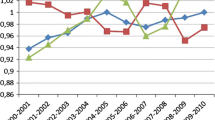Abstract
In a longitudinal panel study design, 80 hospitals in Virginia were selected for analysis to test the hypothesis that the introduction of the prospective payment system (PPS) in October 1983 had helped hospitals enhance their operational performance in technical efficiency. A non-parametric method called Data Envelopment Analysis (DEA) was used to calculate and compare the efficiency scores for each peer group of hospitals (by bed size) between the year 1984 and the year 1993. Contrary to expectations, no significant difference in technical efficiency was found in each hospital peer group over the study period. Nevertheless, the case study demonstrates that if hospital managers use this analytical tool appropriately, they may spot where any organizational weakness lies and how they can improve it.
Similar content being viewed by others
REFERENCES
National Center for Health Statistics. Health, United States, 1995. 1996. (PHS No. 96-1232). Hyattsville, MD: Public Health Service.
Knickman, J.R., and Thorpe, K.E., Financing for health care. In Kovner, A.R., and Jones, S. (eds), Health Care Delivery in the United States, Springer, 1990.
Wan, T.T.H., and Chung, J.S.J., Validating measurement of hospital performance. Paper presented at the 33rd International Conference of the Institute of Operations Research and the Management Sciences, Singapore, June 26, 1995.
Sexton, T.R., Silkman, R.H., and Hogan, A.J., Data envelopment analysis: critique and extensions. In Silkman, R.H. (ed.), Measuring Efficiency: An Assessment of Data Envelopment Analysis, American Evaluation Association, 1986.
Sherman, H.D., Managing productivity of health care organizations. In Silkman, R.H. (ed.), Measuring Efficiency: An Assessment of Data Envelopment Analysis, American Evaluation Association, 1986.
Ehreth, J.L., The development and evaluation of hospital performance measures for policy analysis. Med. Care 32(6):568–87, 1994.
Sexton, T.R., The methodology of data envelopment analysis.” In Silkman, R.H. (ed.), Measuring Efficiency: An Assessment of Data Envelopment Analysis, American Evaluation Association, 1986.
Hollingsworth, B., Dawson, P.J., and Maniadakis, N., Efficiency measurement of health care: a review of non-parametric methods and applications. Health Care Manag. Sci. 2:161–172, 1999.
Ozcan, Y.A., and McCue, M.J., Development of a financial performance index for hospitals: DEA approach. J. Operat. Res. Soc. 47(1):18–26, 1996.
Smith, P., Data envelopment analysis applied to financial statements. Omega 18:131–138, 1990.
Bowlin, W.F., Charnes, A., Cooper, W.W., and Sherman, H.D., Data envelopment analysis and regression approaches to efficiency estimation and evaluation. Annals Operat. Res. 2(1):113–138, 1985.
Charnes, A., Cooper, W.W., Lewin, A.Y., and Seiford, L.M., Data Envelopment Analysis: Theory, Methodology and Application, Kluwer Academic Publishers, 1994.
Norman, M., and Stoker, B., Data Envelopment Analysis: The Assessment of Performance, Wiley & Sons, 1991.
Norton, R. Which offices or stores really perform best? a new tool tells. Fortune 38, Oct. 31, 1994.
Grossfopf, S., and Valdmanis, V., Measuring hospital performance: a nonparametric approach. J. Health Econ. 6:89–107, 1987.
Ozcan, Y.A., Luke, R.D., and Haksever, C., Ownership and organizational performance: a comparison of technical efficiency across hospital types. Medical Care 30(9):781–94, 1992.
Zuckerman, S., Hadley, J., and Iezzoni, L., Measuring hospital efficiency with frontier cost functions. J. Health Econ. 13(3):255–80, 1994.
Ozcan, Y.A., Sensitivity of hospital efficiency under alternative output/input and peer groups: a review. Knowledge and Policy 5(4):1–31, 1993.
Lynch, J.R., and Ozcan, Y.A., Hospital closures: an efficiency analysis. Hosp. Health Serv. Admin. 39(2):205–224, 1994.
Ozcan, Y.A., and Luke, R.D., A national study of the efficiency of hospitals in urban markets. Health Serv. Res. 28(6):719–739, 1993.
Valdmanis, V., Ownership and technical efficiency of hospitals. Medical Care 28(6):552–561, 1990.
White, K., and Ozcan, Y., Church ownership and hospital efficiency. Hosp. Health Serv. Admin. 41(3):297–310, 1996.
Charnes, A., Cooper, W.W., and Li, S., Using data envelopment analysis to evaluate efficiency in the economic performance of Chinese cities. Socio-Econ Planning Sci. 23:325–344, 1989.
Sheingold, S.H., The first three years of PPS: impact on Medicare costs. Health Affairs 8(3):191–204, 1989.
Morey, R., Fine, D., Loree, S., Retzlaff-Roberts, S., and Tsubakitani, S., The trade-off between hospital cost and quality of care: an exploratory empirical analysis. Med. Care 30(8):677–698, 1992.
Author information
Authors and Affiliations
Rights and permissions
About this article
Cite this article
Chern, JY., Wan, T.T.H. The Impact of the Prospective Payment System on the Technical Efficiency of Hospitals. Journal of Medical Systems 24, 159–172 (2000). https://doi.org/10.1023/A:1005542324990
Issue Date:
DOI: https://doi.org/10.1023/A:1005542324990




